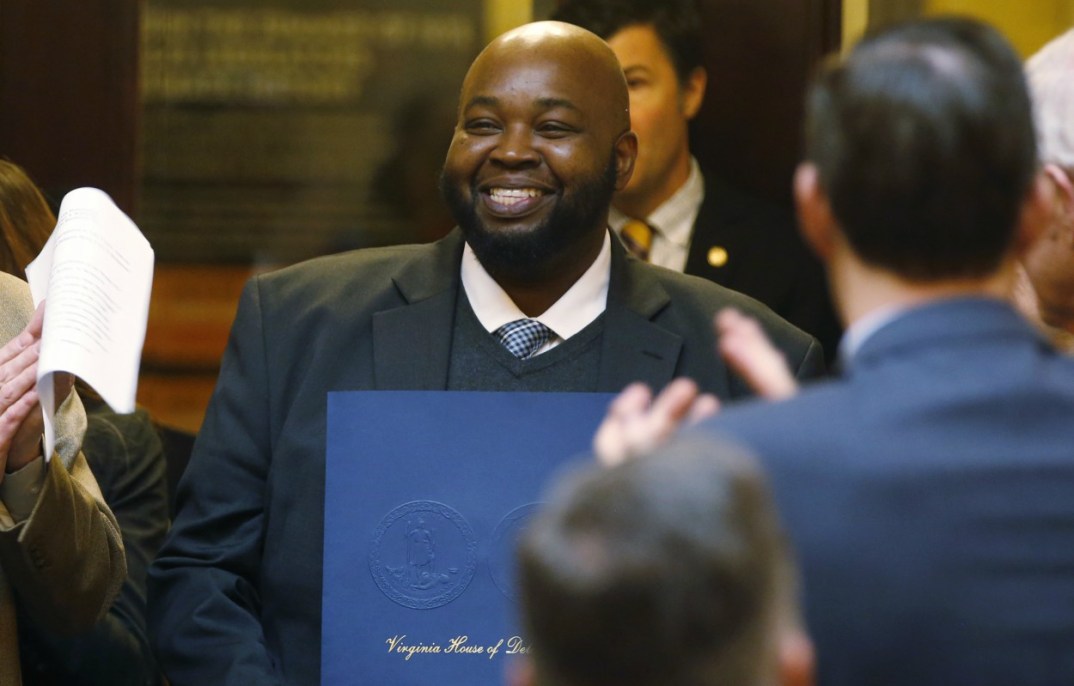Juvenile detention educator chosen as 2019 Teacher of the Year
Rodney Robinson has specialized at instructing socially challenged youth in Virginia and made real changes in his school and the detention center where he gives kids a second chance

RICHMOND, Va. (AP) — As a veteran teacher at a troubled high school in Richmond, Virginia, Rodney Robinson wanted to better understand why so many students go directly from school to prison. So he took a job teaching students at a juvenile detention center.
Four years later, Robinson has been chosen as the 2019 National Teacher of the Year for his dedication to helping disadvantaged students move beyond their mistakes.
“I give my kids empathy, not sympathy, and that’s the key,” Robinson told The Associated Press.
“It’s all about empathizing — understanding their situation, but teaching them how to overcome.”
READ MORE: Kenyan teacher who gave his all to the poor earns $1m prize in global teacher competition
Robinson’s selection from among 57 award-winning teachers around the country was announced Wednesday by the Council of Chief State School Officers.
As Teacher of the Year, Robinson will spend the next year traveling the country to advocate for students and teachers. He said he plans to focus on ensuring equity for all students and recruiting more Black and Hispanic men as teachers. Robinson is among just about 2% of teachers in U.S. public schools who are black men. Another 2% are Hispanic men.
“The education system needs to look more like America,” he said.
Robinson, 40, became a teacher to honor his mother, who struggled to get her high school diploma amid poverty and segregation in rural Virginia. When Robinson was in high school, his mother went back to school to get her GED, an experience that made Robinson understand the joy of learning.
“I saw a different side of my mother in those classes, and I really enjoyed that side. I was like, is this what learning does? It inspires this type of feeling?” he said.
READ MORE: Kamala Harris proposes plan to hike teacher pay; says Black students and schools will benefit
“That really inspired me to become a teacher.”
Robinson has spent most of his 19-year career teaching social studies at Armstrong High School, a struggling school in a section of Richmond plagued by crime and violence. But where most people saw obstacles, Robinson saw “love and the commitment to do better in life.”
After 12 years there, Robinson started to feel burned out and disillusioned. But when his principal asked him if he knew any teachers who would be willing to take on teaching students at the juvenile detention center, he said he would take the job himself.
At the time, in 2015, the Center for Public Integrity had just issued a report analyzing U.S. Department of Education data that showed Virginia led the nation in referrals of students to law enforcement. Robinson wanted to know why.
“What better way to learn about the school-to-prison pipeline than to go into an actual jail or prison and teach the children,” he said.
Robinson went to work at the Virgie Binford Education Center, immediately changing the look of the school inside the detention center, filling its blank, white walls with color: a historical timeline and images of President Barack Obama, Oprah Winfrey and other heroes to the students. The crimes the youths are charged with range from robbery and breaking and entering all the way up to murder.
READ MORE: Teacher gives master class slavery lesson for Black History Month to sixth grade students
“We hung college banners on all the walls, just to let the kids know that this is just a temporary spot. You can still achieve your goals in life,” he said.
Robinson said he tries to provide stability, boost self-esteem and to create an environment where the students — ages 12 through 19 — feel appreciated.
“You have to make sure they’re comfortable and meet their needs. Once you do that, then the sky is the limit,” he said.
During his four years at the detention center, he’s seen some heartbreaking things that might have sent other teachers looking for another job. He tells the story of two students he assigned to work on a project together. Six months later, one of the students was dead and the other was charged with his murder.
“Having to compartmentalize that and still give that kid a quality education, that’s hard,” he said.
As Teacher of the Year, Robinson is looking forward to telling the story of his students. One former student now works for a group that advocates for alternatives to youth incarceration. Some students have arrived at the detention center two or three years behind in their school work, but have caught up and managed to graduate on time. Others have been able to improve their reading levels by multiple grades in a couple of months.
“My kids have overcome some tremendous odds and been through some traumatic, horrific circumstances, yet they still triumph, they still have dreams, they will want to be doctors and lawyers and everything you can of,” he said.
“Helping kids channel all that energy and dreams into something positive to where they can see an outcome and a result, that is what I love most about teaching.”
